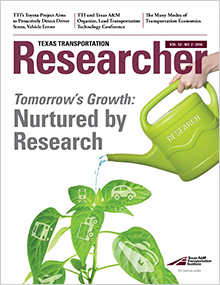Things are looking up for the U.S. economy. Or that’s what freight moving across the U.S.-Mexico border between 2012 and 2014 seems to indicate.
There are 25 land ports of entry (POEs) along the 1,969-mile U.S.-Mexico border that serve as trade gateways between the two countries. Recent negative changes in the global economy resulted in a significant decline in trade and freight movement worldwide. This downturn prompted the United States to examine its border trade more closely. What goods are moving where? What POEs are most popular? What transportation modes are favored?
Despite the recession of the early 2000s and the global financial crisis of 2007, surface trade between the United States and Mexico essentially quadrupled from approximately $100 billion in 1995 to $400 billion in 2012. Since 2009, the Texas A&M Transportation Institute’s (TTI’s) Center for International Intelligent Transportation Research (CIITR) has studied the freight activities of U.S.-Mexico POEs in Texas, California, Arizona and New Mexico. Using data from the Trans-Border Surface Freight Database of the U.S. Bureau of Transportation Statistics, CIITR researchers identify and study trends in what commodities move across the border and quantify any noted changes. As part of the analysis, freight is classified by mode of transport (e.g., trucks and railcars, empty and loaded), six commodity groups and freight destinations.
“The steady upward trend between 2010 and 2012 essentially leveled off for about a year through mid-2013,” explains TTI Associate Research Engineer Geza Pesti. “But since then and through 2014, surface trade between the United States and Mexico recovered its upward momentum.”
Pesti and his team also identified those interior U.S. states, including Michigan and Illinois, with businesses generating significant surface trade with Mexico, usually via Texas POEs. Knowing the destinations of frequent shipments from Mexico can help state officials to better prioritize border-related transportation infrastructure needs, thereby maximizing the economic benefits of efficient trade for those states and the nation as a whole.
In 2014, cross-border trade grew by 7 percent — up from the anemic 1 percent low point of the year before. Maintaining its longitudinal ratio, the value of U.S. imports was about 25 to 35 percent higher than exports: 44 percent of the total surface trade with Mexico was exports, while 56 percent was imports. Another consistent factor over time — trucking dominated freight movement in 2014 as well, accounting for 82 percent of trips in both directions, with rail (18 percent export and 15 percent import) making up the difference.
Freight activities at Texas POEs (particularly Laredo) are considerably greater than in the other four states that border Mexico combined. Though still the primary trading partner with Mexico among all U.S. states, Texas did experience a 1.4 percent reduction in the value of its surface trade with its neighbor to the south in 2014. And wait times for commercial vehicles — a new facet of the study, with data analyzed between May 2013 and December 2014 — yielded some interesting findings.
On weekdays, commercial vehicles crossing the border in Pharr and at the World Trade Bridge in Laredo experienced the longest wait times at more than 60 minutes. Shippers using other POEs, like Brownsville, Zaragoza and the Columbia Bridge, experienced significant wait times as well, often approaching an hour. The longest day to wait? Put it this way: don’t try to move cross-border freight on Saturdays.
“Knowing when freight is slowing down at the border gives local authorities on both sides an opportunity to focus on improving mobility at those times,” says Pesti. “More efficient freight movement means improved just-in-time delivery and can result in reduced shipping costs that ultimately benefit the consumer.”
Armed with findings from Pesti’s study, policy makers can make more data-based decisions regarding, for example, allotting their state department of transportation’s limited resources to facilitate trade (e.g., prioritizing the repair of roads used by long-haul trucks). Members of the driving public can plan cross-border leisure and business travel around peak bottleneck times. And environmental agencies can more easily mitigate border-town air pollution caused by the long wait times by knowing when and where it’s likely to be worst.
Pesti and his team are currently analyzing 2015 data to update the ongoing study.


